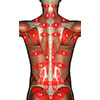All muscles will get tired when overused either too intensively or for too long without rest.
When muscles get tired they will cause pain and feel weak. After a while they will tighten and shorten, thus compounding the problem by restricting both movement and blood supply.Every muscle in the body has a purpose. They all operate some movement or part of a movement.
Back pain often means more than just giving you a pain in the back. It can create difficulties with walking, sitting, bending and lifting and can even lead to depression and breathing difficulties. It can also be the cause of pain in the buttocks, groin and legs, sciatica is a good example. Over 2.8 million adults in the UK of all ages suffer from long term back pain, enduring months and years of discomfort
The most common cause is a 'pulled' muscle?
There are 5 ways to 'pull' a muscle or 'strain it'.1. By overstretching a muscle or muscle group. For example, imagine trying to put a baby seat into the back of seat of your car. The baby chair is light enough but the action requires a lot of stretching of the muscles as we reach forward with the chair. Then the muscles must contract to lift us back out of the car. An awkward movement, simple and everyday. The muscles can first strain through overstretching, then strain again when they over-contract.
2. By sudden movements and falls. Take the example above and imagine that in the middle of placing the baby seat someone honks their horn at you, you suddenly jerk, hit your head on the car roof and shout an appropriate obscenity. Some hours later you are flat on your back in agony.
3. Falls and other trauma can obviously pull and even tear muscle fibres. Even a small amount of 'damage' will spread to the neighbouring areas compounding the problem.
4. Pre-existing problems can be re-activated when we injure ourselves. Sometimes even when the area of injury is far removed from our 'old' problem areas.

5. Posture is king. Whilst slouching in the sofa we are usually putting our spine, neck and ribcage into extreme positions which soon proves to have been a painful mistake. We eventually reach the bent over old person appearance, the couch-potato look.
Sometimes a disc can bulge or rupture. This can cause intense pain down the leg with pins and needles and numbness in the foot. Given time the condition usually improves. Treatment will help to accelerate recovery. When the damage is too severe surgery may be necessary. Surgery on the spine is not to be feared it is usually quite succesful.
 Pain Mapper:
Pain Mapper: